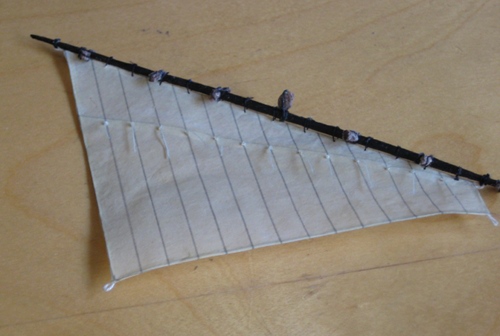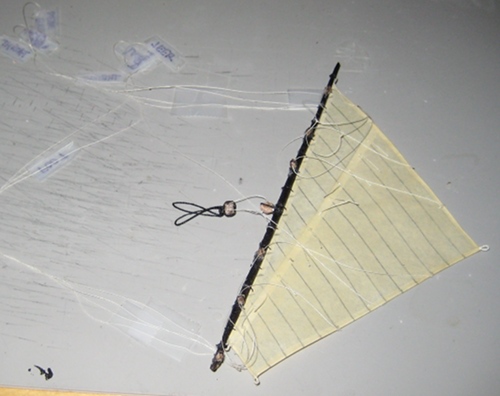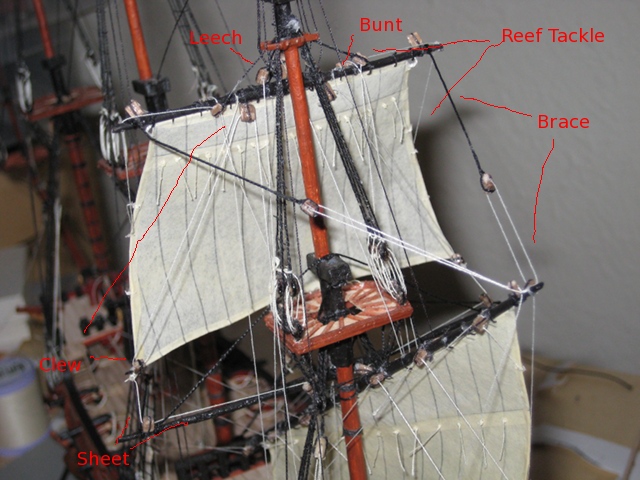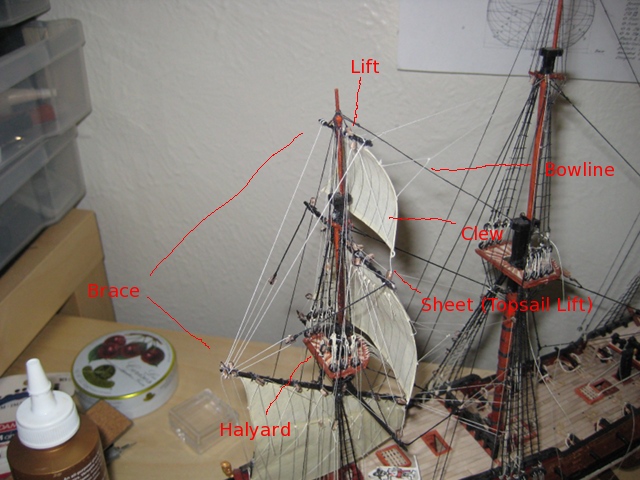Building the Peregrine Galley: Running Rigging of the Mizzen Mast
Mizzen Course (Lateen Sail)
This is definitely the wacky sail on the ship, working completely differently from all the other sails. The picture below shows the mizzen course bent to the yard; the big block in the middle is for the halyard and the rest are for the brails (peak, throat, and foot).

Attach lines to the sail before it is attached. The ropes for the halyard are already threaded through the standing blocks; we attach the blocks to the mast and the rest of the sail goes along with it. The other lines you see are the brails.

Below shows most of the running rigging. The tack and sheet are not yet attached but they are self-explanatory. There is no mizzen lift; according to Anderson, by this time, the mizzen course lift was unrove once the yard was up; the topsail and topgallant would interfere with the usual run to the mainmast.

The foot brails and bowlines all run to the aftmost main shroud. This picture shows the run of the lines.

In more detail:
Mizzen Course Jeers
The jeer goes through a single block on the yard and a double block stropped to the mast head. The double block has two "loops" which are threaded through with another rope and secured thus to the masthead; this allows the loops to fall through the lubber's holes and thus bring the double block as close as possible to the knees without fouling the mizzen stay.
The jeer starts just fore of the block on the yard, runs up to the double block, back to the single block on the yard, up again to the double block, and then down to the deck. Belay on the mizzen bitts.
Mizzen Course Bowlines (Braces)
They are called bowlines, but they are actually more like braces. There are two of these. They start from the aftmost main shroud, go to a block at the foot of the lateen yard, back to a block just below the starting point on the main shroud, then to a belaying point in the fore end of the quarterdeck.
Mizzen Course Sheet
Run this to a tackle by the stern counter.
Mizzen Course Peak Brails
There are block each side for the peak brails, but they are bound by a single rope (in the photo you can see lines coming from the two blocks that seem to merge to a point to a single line; this is what I am talking about). Another rope is hooked into this and forms the running end. Belay the running end to the quarterdeck rail, near the main topmast backstays.
Mizzen Course Throat Brail
There is one per side and it consists of a single line that is run through the block and then directly to the belaying point just forward of the peak brails.
Mizzen Course Foot Brails
There are two per side, each consisting of a single rope. The lead goes from the foot of the sail to a block on the yard, then to a block on the aftmost main shroud, and then down to be belayed to the main shroud deadeyes.
Mizzen Course Tack
The tack runs from the front lower corner directly to an eyebolt in the deck. It is a single line, no blocks or anything.
Crossjack Yard
Obviously the crossjack is the simplest of the square yards as it carries no sail. Thread the halyard and the topsail sheets before sending up the yard. The inner block for the topsail sheet will be inaccessible after the yard goes up.

The following picture shows the running rigging on the crossjack. Note that the topsail sheet is there but not yet attacked to the topsail, which goes up next.

In more detail:
Crossjack Sling
The crojack is held by a sling and has no halyards, jeers, or anything like that fitted while the ship was underway. The sling goes through a single block stropped to the center of the yard.
Crossjack Standing Lift
More like a piece of standing rigging. A single line goes from the yard towards the mizzen cap. The other end is a pendant with a deadeye; the whole thing is tensioned with deadeyes. At this scale, I simplify it with just a single piece of line. It is a little hard to see in the photo but it is the dark line running past the mizzen top.
Crossjack Brace
Attach a pendant with a single block to each end of the yard. A fall starts from the aftmost main shroud, goes through the block, then to a block below the starting point on the aftmost shroud, then down to the deck. I belay it to the second-to-aft main shroud.
Mizzen Topsail
The mizzen topsail is not much different from the other topsail yards.
Rear view of the mizzen topsail:

From the front side:

Mizzen Topsail Halyard
This one has a single block on the yard and a single block stropped to the topmast head, hanging just below the crosstrees. The lead runs from the single block on the topmast head down to the block on the yard and then back up. It then runs down to the deck. I belay it to the starboard rail aft of the mizzen channels.
Mizzen Topsail Lifts
Doubles as the mizzen topgallant sheet, like the others. A single line starts from the topgallant clew goes down to the block on the yard, back up to a block below the starting point, then down to the deck. I belay to the rail aft of the mizzen channels. This does not appear in the photo as it cannot go up until the topgallant is in place.
Mizzen Topsail Brace
The braces are single blocks on a pendant. The line starts from the peak of the mizzen course, up to the block, then to a block on the mizzen course below the starting point, then back to the deck. I use the last quarterdeck timber.
Mizzen Topsail Sheet
Goes from clew down to block on the crojack, across to a block near the center of the crossjack, then down to the deck. Very much like a standard topsail. Belay to the mizzen sheet bitts. Recall that we first put up the line with the crossjack but could not tie it off until now.
Mizzen Topsail Clewline
Much like a standard topsail. Start from the yard, down to a block on the clew, back up to a block on the yard, then down. Belay immediately aft of the mizzen channels.
Mizzen Topsail Bowlines
Like other topsail bowlines, but the run goes to the aftmost main shroud above the crossjack braces and below the futtock stave. Belay down on the rail near the crossjack brace (near the aftmost shroud).
Mizzen Topsail Buntline
Simplified slightly from actual practice - I just run them from the foot of the sail up to a leading block on the yard and then directly down behind the sail to the belaying point (skipping the pendant). Belay on the rail immediately before the mizzen channels.
Mizzen Topsail Leechline
Goes from the leech up to a leading block on the yard, up to a block on a pendant from the topmast head, then back down to the rail. Belay near the buntline.
Mizzen Topsail Reef Tackle
A single line running from the reef cringle through the yard, up to a block on a pendant, and then down to the mizzen top. Belay on one of the deadeyes (I used the foremost deadeye).Mizzen Topgallant Sail
The picture below shows the running rigging for the mizzen topgallant sail. Note that the topgallant sheet doubles as the topsail lift.

Mizzen Topgallant Halyard
The halyard is tied directly to the yard and runs through a sheave in the topgallant mast. Set up a tackle on the mizzen top to haul it in.
Mizzen Topgallant Lifts
Starts from the yard, goes to a block on a pendant hanging from the topgallant head, then down. Like the other topgallant lifts, it belays in the top on one of the deadeyes; I used the middle deadeye.
Mizzen Topgallant Braces
Runs like the mizzen topsail brace, to the peak of the course and then down to the deck. This one is a single line, however, with no pendant.
Mizzen Topgallant Sheets
This doubles as the mizzen topsail lift, hook up the line here.
Mizzen Topgallant Clewline
A single line, belaying to the top (I used the aft deadeye), run like any other topgallant clew (ie, no block on the clew).
Mizzen Topgallant Bowline
Runs to a block on the main topmast trestletrees, then down to the main top. Belay to a deadeye.